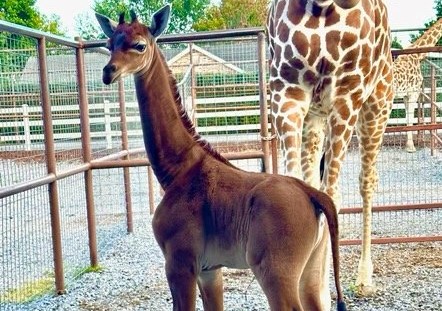
The World’s rarest giraffe with a unique pattern is gaining widespread attention on the internet. This special giraffe was born in a zoo located in Limestone, Tennessee, and what sets it apart is its lack of spots.
The team of zookeepers at Brights Zoo has given a special name to the female giraffe with a brown coat. She was born on July 31st. They’re calling her “the world’s rarest” among her kind.
Only giraffe of its kind
The experts at the zoo believe that she might be the only giraffe of the reticulated species (scientifically known as Giraffa reticulata) with a solid-colored coat. This information comes from an official statement released by the zoo.
Even though she’s just a few weeks old, this long-necked creature stands at an impressive height of six feet (1.8 meters).
The last time a spotless reticulated giraffe was spotted was in the 1970s. Back then, a baby giraffe named Toshiko was born without spots in a Japanese zoo.
Importance of giraffe spots
Giraffe spots are extremely important for these animals to stay safe, especially in the wild. Out there in the African savannas, where they live, these colored patches work like camouflage. They help the giraffes blend in with their surroundings in order to hide from predators.
One of the world’s rarest giraffes was born at Brights Zoo on July 31st in Tennessee.
Giraffe experts believe she is the only solid-colored reticulated giraffe living anywhere on the planet.
The baby giraffe is six feet tall and is “thriving” under her mother’s care. 🦒❤️… pic.twitter.com/99IwybkEIk— ∼Marietta (@MariettaDaviz) August 22, 2023
Yet, their spots serve more than just camouflage. Under each spot, there’s a complex network of blood vessels. These vessels divide into smaller ones which help the giraffes release body heat. This also means that the unnamed baby giraffe could be more prone to overheating.
The Giraffe Conservation Foundation confirms that there are roughly sixteen thousand reticulated giraffes left in their natural habitats. This marks a significant drop of fifty percent over the last three and a half decades. Earlier, there were around thirty-six thousand of these giraffes living in the wild on the continent.
Current health of baby giraffe
Although the baby giraffe without spots is currently in good health, giraffes in their natural habitats are facing serious challenges.
According to Tony Bright, the founder of the zoo, “Giraffes in the wild are quietly moving towards disappearing forever. In the past thirty years alone, we’ve lost 40 percent of the giraffe population in the wild.”
The new giraffe is being taken care of by her watchful mother and the dedicated zoo staff. Now, the only thing left is to give her a name. Right now, the zoo is hosting a contest on its Facebook page to choose a name for their newest family member, the baby giraffe.
See all the latest news from Greece and the world at Greekreporter.com. Contact our newsroom to report an update or send your story, photos and videos. Follow GR on Google News and subscribe here to our daily email!



